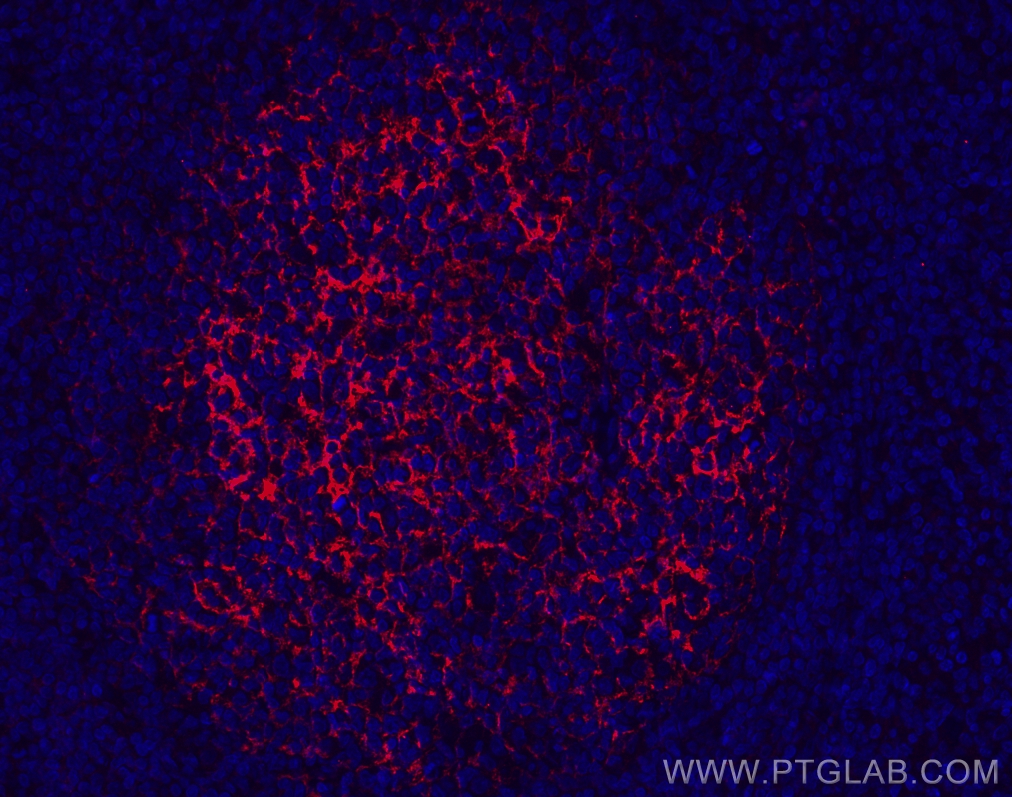验证数据展示
经过测试的应用
| Positive IF-P detected in | human tonsillitis tissue |
推荐稀释比
| 应用 | 推荐稀释比 |
|---|---|
| Immunofluorescence (IF)-P | IF-P : 1:50-1:500 |
| It is recommended that this reagent should be titrated in each testing system to obtain optimal results. | |
| Sample-dependent, Check data in validation data gallery. | |
产品信息
CL594-60208-2 targets CD23 in IF-P applications and shows reactivity with human, mouse samples.
| 经测试应用 | IF-P Application Description |
| 经测试反应性 | human, mouse |
| 免疫原 |
CatNo: Ag0425 Product name: Recombinant human CD23,FCER2 protein Source: e coli.-derived, PGEX-4T Tag: GST Domain: 48-248 aa of BC064417 Sequence: DTTQSLKQLEERAARNVSQVSKNLESHHGDQMAQKSQSTQISQELEELRAEQQRLKSQDLELSWNLNGLQADLSSFKSQELNERNEASDLLERLREEVTKLRMELQVSSGFVCNTCPEKWINFQRKCYYFGKGTKQWVHARYACDDMEGQLVSIHSPEEQDFLTKHASHTGSWIGLRNLDLKGEFIWVDGSHVDYSNWAPG 种属同源性预测 |
| 宿主/亚型 | Mouse / IgG2a |
| 抗体类别 | Monoclonal |
| 产品类型 | Antibody |
| 全称 | Fc fragment of IgE, low affinity II, receptor for (CD23) |
| 别名 | C-type lectin domain family 4 member J, CLEC4J, CD23A, BLAST-2, BLAST 2 |
| 计算分子量 | 321 aa, 36 kDa |
| 观测分子量 | 40 kDa |
| GenBank蛋白编号 | BC064417 |
| 基因名称 | CD23 |
| Gene ID (NCBI) | 2208 |
| 偶联类型 | CoraLite®594 Fluorescent Dye |
| 最大激发/发射波长 | 588 nm / 604 nm |
| 形式 | Liquid |
| 纯化方式 | Protein A purification |
| UNIPROT ID | P06734 |
| 储存缓冲液 | PBS with 50% glycerol, 0.05% Proclin300, 0.5% BSA, pH 7.3. |
| 储存条件 | Store at -20°C. Avoid exposure to light. Stable for one year after shipment. Aliquoting is unnecessary for -20oC storage. |
背景介绍
CD23, also known as low affinity immunoglobulin epsilon Fc receptor, is a transmembrane glycoprotein present on a subpopulation of B lymphocytes in germinal centres, EBV-transformed B-lymphoblastoid cell lines, follicular dendritic cells, and a subpopulation of peripheral blood cells. CD23 has essential roles in the regulation of IgE production and in the differentiation of B-cells.
实验方案
| Product Specific Protocols | |
|---|---|
| IF protocol for CL594 CD23 antibody CL594-60208-2 | Download protocol |
| Standard Protocols | |
|---|---|
| Click here to view our Standard Protocols |
